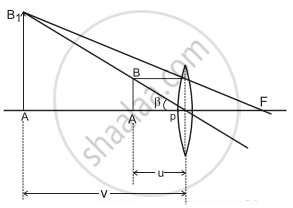Advertisements
Advertisements
Question
Answer the following question in detail.
Derive an expression for the magnifying power of a simple microscope. Obtain its minimum and maximum values in terms of its focal length.
Solution
- Figure (a) shows the visual angle α made by an object when kept at the least distance of distinct vision (D = 25 cm). Without an optical instrument, this is the greatest possible visual angle as we cannot get the object closer than this.

(a) Visual Angle α
(b) Visual Angle β - Figure (b) shows a convex lens forming an erect, virtual, and magnified image of the same object when placed within the focus.
- The visual angle β of the object and the image, in this case, is the same. However, this time the viewer is looking at the image which is not closer than D. Hence the same object is now at a distance smaller than D.
- Angular magnification or magnifying power, in this case, is given by
M = `"Visual angle of the image"/"Visual angle of the object at D"=β/α`
For small angles
M = `β/α≈(tan(β))/(tan(α))=("BA/PA")/"BA/D"="D"/"u"` - For maximum magnifying power, the image should be at D. For a thin lens, considering thin lens formula, `1/"f"=1/"v"-1/"u"`
In case of simple microscope,
f = +f, v = – D, u = – u and M = Mmax
∴ `1/"f"=1/-"D"-1/-"u"`
∴ `"D"/"f"="D"/-"D"+"D"/"u"`
As, M = `"D"/"u"`,
Mmax = `1+"D"/"f"` - For minimum magnifying power, v = ∞ and u = f (numerically)
∴ Mmin = `"D"/"u"="D"/"f"`
APPEARS IN
RELATED QUESTIONS
Answer the following question in detail.
Define and describe the magnifying power of an optical instrument.
Answer the following question in detail.
How does magnifying power differ from linear or lateral magnification?
Answer the following question in detail.
Obtain the expressions for magnifying power and the length of an astronomical telescope under normal adjustments.
Answer the following question in detail.
What is the limitation in increasing the magnifying powers of a simple microscope?
Answer the following question in detail.
What is the limitation in increasing the magnifying powers of a compound microscope?
Discuss about simple microscope and obtain the equations for magnification for near point focusing and normal focusing.
What is the use of an erecting lens in a terrestrial telescope?
What is the remedy of myopia?
What is astigmatism? What is its remedy?
Obtain the equation for resolving the power of the microscope.
Explain the experimental determination of the material of the prism using a spectrometer.
A compound microscope has a magnification of 30. The focal length of eye piece is 5 cm. Assuming the final image to be at least distance of distinct vision, find the magnification produced by the objective.
A compound microscope has a magnifying power of 100 when the image is formed at infinity. The objective has a focal length of 0.5 cm and the tube length is 6.5 cm. What is the focal length of the eyepiece.
A light wave of wavelength λ is incident on a slit of width d. The resulting diffraction pattern is observed on a screen at a distance D. If linear width of the principal maxima is equal to the width of the slit, then the distance D is
There are four convex lenses L1, L2, L3 and L4 of focal length 2, 4, 6 and 8 cm, respectively. Two of these lenses from a telescope of length 10 cm and magnifying power 4. The objective and eye lenses are respectively
When a convex lens of 12.5 cm focal length is used as a magnifying glass, normal eye can see an object clearly at a distance of 25 cm. The magnifying power of the instrument is ____________.
If astronomical telescope of length 1.53 m has magnifying power of magnitude 50, the values of fo and fe are ____________.
The magnifying power of a telescope is nine. When it is adjusted for parallel rays, the distance between the objective and eyepiece is 20 cm. The focal length of objective and eyepiece are respectively.
The magnifying power of a telescope is high if its objective and eyepiece have respectively ______.
A simple microscope is used to see the object first in blue light and then in red light. Due to the change from blue to red light, what is the effect on its magnifying power?
An object viewed from a near point distance of 25 cm, using a microscopic lens with magnification '6', gives an unresolved image. A resolved image is observed at infinite distance with a total magnification double the earlier using an eyepiece along with the given lens and a tube of length 0.6 m, if the focal length of the eyepiece is equal to ______ cm.
Magnification produced by astronomical telescope for normal adjustment is 10 and length of telescope is 1.1 m. The magnification when the image is formed at least distance of distinct vision (D = 25 cm) is ______.
An observer looks at a distant tree of height 10 m with a telescope of magnifying power of 20. To the observer the tree appears:
The image formed by an objective of a compound microscope is ______.
A camera objective has an aperture diameter of d. If the aperture is reduced to diameter d/2, the exposure time under identical conditions of light should be made ______.
